COMPOST, LOOKING AHEAD, LOOKING BACK
/4 Comments/in Soil/by Lee ReichSpring Readiness
I’m frantically getting ready for spring. A large portion of that readying means making compost. Compost piles assembled now, while temperatures are still relatively warm, have plenty of time to heat up right to their edges, quickly cooking and killing most resident weed seeds, pests, and diseases.
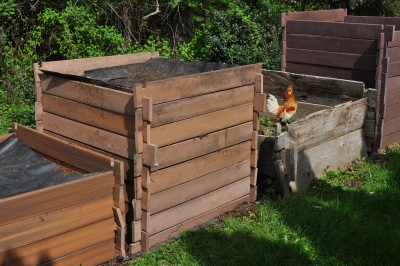 I like to think of my compost pile as a pet (really, many pets, the population of which changes over time as the compost ripens) that needs, as do our ducks, dogs and cat, food, water, and air. Today I’ll feeding my pet — my compost pet — corn stalks, lettuce plants that have gone to seed, rotten tomatoes and peppers, and other garden refuse. Plenty of organic materials are available to feed compost piles this time of year.
I like to think of my compost pile as a pet (really, many pets, the population of which changes over time as the compost ripens) that needs, as do our ducks, dogs and cat, food, water, and air. Today I’ll feeding my pet — my compost pet — corn stalks, lettuce plants that have gone to seed, rotten tomatoes and peppers, and other garden refuse. Plenty of organic materials are available to feed compost piles this time of year.
In case you’re wondering, no, I’m not taking a close look at each leaf, stalk, and fruit to make sure it’s free of pests before getting tossed on the growing pile, as is suggested by some people. Look closely enough, and you’d find that just about everything would have some hostile organism on it. But given some combination of time and heat, a well-fed compost pile will take care of such potential problems.
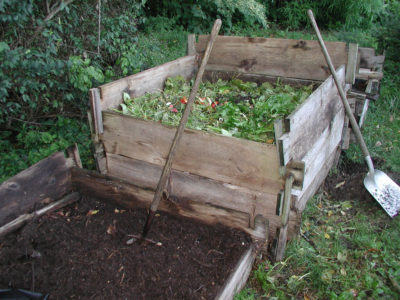 Joseph Jenkins, in his excellent (and fun-to-read) book, The Humanure Handbook, quotes research showing complete destruction of human pathogens in humanure composts that reach 145°F for one hour, 122°F for one day, or 109° F for one week. The same should be true for plant pathogens and pests. For decades, I’ve tossed everything and anything into my compost piles and never noticed any carry over of pest or disease problems.
Joseph Jenkins, in his excellent (and fun-to-read) book, The Humanure Handbook, quotes research showing complete destruction of human pathogens in humanure composts that reach 145°F for one hour, 122°F for one day, or 109° F for one week. The same should be true for plant pathogens and pests. For decades, I’ve tossed everything and anything into my compost piles and never noticed any carry over of pest or disease problems.
Heat and time also do in weed seeds. Survival depends on the kind of weed: Research shows that a couple of weeks at 114°F kills pigweed seeds, while only about a week at that temperature kills seeds of tomatoes, peppers and their other kin in the nightshade family. Generally temperatures of 131°F for a couple of weeks kills most weed seeds.
Heat and time aren’t the only threats faced by pathogens, pests, and weed seeds in the innards of my compost piles. In addition to heat, various antagonistic organisms — including friendly (to us) bacteria, fungi, and nematodes — stand ready to inhibit their growth or gobble them up.
 This time of year, my compost piles dial the heat up to around 140°F, and hold that temperature for a couple of weeks, or more, before slowly cooling down.
This time of year, my compost piles dial the heat up to around 140°F, and hold that temperature for a couple of weeks, or more, before slowly cooling down.
Weedy Revenge
Speaking of weeds, they also make excellent food for my compost pet. What sweet revenge I get tossing mugwort, creeping Charlie, and woodsorrel onto a growing compost pile and then get them back transmuted as dark, rich compost.
Other organic materials that go into my compost piles are a mix of goldenrod, bee balm, grasses, yarrow, and whatever else is growing in my south field. I cut parts of it with a scythe, let the scythings wilt for a day, then rake and pitchfork them up.
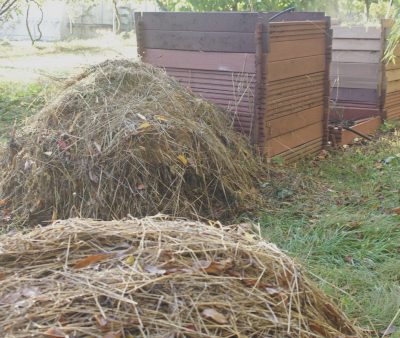 Also on the menu is some horse manure from a nearby stable, which I like mostly for the wood shavings that provide bedding for the horses. The manure itself furnishes nitrogen, which compost pets need for a balanced diet — 20 parts carbon to 1 part nitrogen but no need to be overly exacting because it all balances out in the finished compost. Lacking manure, soybean meal is another nitrogen-rich feed, as are grass clippings and kitchen waste.
Also on the menu is some horse manure from a nearby stable, which I like mostly for the wood shavings that provide bedding for the horses. The manure itself furnishes nitrogen, which compost pets need for a balanced diet — 20 parts carbon to 1 part nitrogen but no need to be overly exacting because it all balances out in the finished compost. Lacking manure, soybean meal is another nitrogen-rich feed, as are grass clippings and kitchen waste.
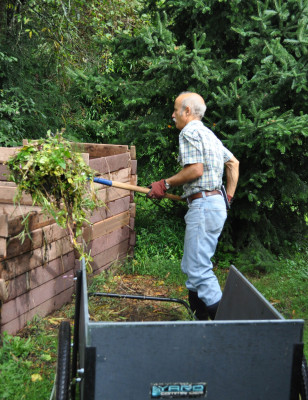 Feeding a variety of compost foods provides a smorgasbord of macro- and micronutrients to the composting organisms and, hence, to my plants. Every few inches I also sprinkle on some soil, to help absorb nutrients and odors, and some ground limestone, to lower acidity of our naturally increasingly acidic soils, and to improve the texture of the finished compost.
Feeding a variety of compost foods provides a smorgasbord of macro- and micronutrients to the composting organisms and, hence, to my plants. Every few inches I also sprinkle on some soil, to help absorb nutrients and odors, and some ground limestone, to lower acidity of our naturally increasingly acidic soils, and to improve the texture of the finished compost.
The Annual Cycle of Compost Here
Compost made this time of year typically gets turned next spring, then, later in the growing season, pitchforked into the garden cart for spreading on vegetable beds.

A one-inch depth of ripened compost supplies all that bed needs to grow intensively planted vegetables there for the whole growing season. It was too late to plant a late vegetable crop in the bed I just cleared of old corn stalks, so I blanketed that bed an inch deep in compost. The same goes for a bed in which grew an early planting of zucchini.
It was too late to plant a late vegetable crop in the bed I just cleared of old corn stalks, so I blanketed that bed an inch deep in compost. The same goes for a bed in which grew an early planting of zucchini.
Any beds that get cleared before the end of this month will get, before I lay down that blanket of compost, a dense sprinkling of oat seeds. The seeds will germinate and the seedlings will thrive in the cool weather of autumn and early winter.

This “cover crop,” as it is called, protects the soil surface from pounding rain and insulates the lower layers. The oat roots latch onto nutrients that might otherwise wash down through the soil. And as the roots grow, they nudge soil particles this way and that, giving the ground a nice, crumbly structure that garden plants like so well.
Beds cleared after October 1st get only compost, no oats, which is almost as good. In all honesty, I’ve never noted any difference in the soil or in vegetable plant growth from using compost alone as opposed to compost plus a cover crop. That much compost, year after year, probably way overshadows the effect of a cover crop. The green cover does look nice going into winter, though.
(I deal more in-depth with composting, using compost, and cover crops in my book Weedless Gardening.)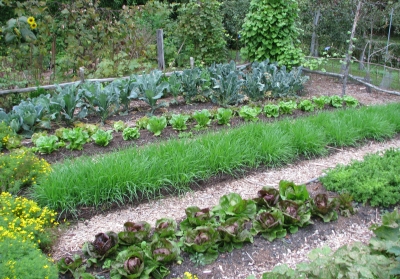
AN ANCIENT FRUIT, STILL POPULAR
/31 Comments/in Fruit/by Lee ReichYou’ve caught me at a good time. I’m just now dipping my toes into figdom, and in the next few days expect to be swimming in a sea of fresh, ripe figs.
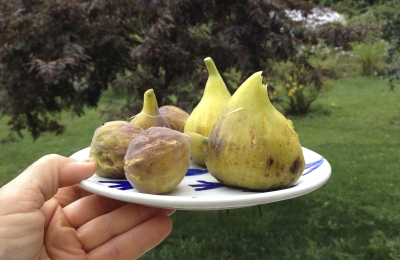
You’ve never tasted a fresh, ripe fig? Don’t judge them by what you might buy in the market. Ripe figs are very perishable so for commercial purposes must be harvested slightly underripe. But figs don’t ripen at all after harvest, which is why market figs are but a shadow of the real thing.
Fresh, ripe figs are ubiquitous in California, Florida, and other mild winter regions, so perhaps are ho-hum to those living in those parts. Not here in New York’s Hudson Valley though, where winter temperatures dipping to minus 20 degrees Fahrenheit are no surprise!
Five Ways with Figs
I — and you —can grow figs in cold climates by one of five techniques I describe in my new book, hot off the press, Growing Figs in Cold Climates. The easiest way is to just plant the fig in a pot that can bask in sunlight outdoors in summer, and then be moved to a cold (ideally 30-45° F), but not frigid, location for winter. Figs are subtropical, not tropical plants, that actually enjoy this winter rest.
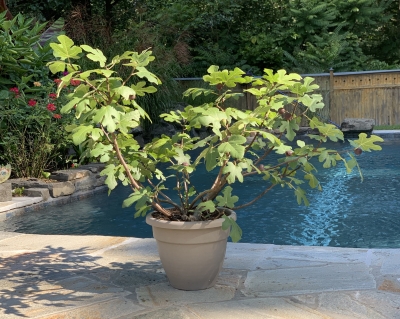
Fortunately, fig is a very adaptable plant. You can lop back its roots each winter, so you can pack new soil around its roots without having to move the plant to a bigger . . . and bigger . . . and bigger pot. You can prune stems more severely that most other fruit plants so it can be maneuvered through doorways for its winter rest. And no need for light in winter. And no pollination is necessary. And pest problems are rare.

Of course, there’s lots of wrinkles to getting a fig plant to fruit well in a pot: What’s the best potting mix? How do you prune for best yields? When do you move the plant to its winter quarter, to its summer quarters? How do you hold back growth waiting for equable spring weather?
Another method that I describe in my book is planting a fig tree outdoors (yes, here, where winters are frigid) and training it as an espalier. Espalier is the training of a plant’s stems, often a fruit plant, to an orderly, usually two dimensional pattern. With fruit plants generally, and figs specifically, the result is more than just good looks; you get to pick lots of very high-quality fruit.

I have trained my plant to the form of an upside down L, consisting of a foot-high, permanent trunk and one permanent, horizontal “arm.” (I’m starting another plant, this one trained to a low T, with horizontal arms running in opposite directions.) Each summer vigorous shoots grow from the topside of the arm and bear fruits. New figs are born along the ever elongating shoots, ripening over a long period beginning with the oldest ones, lower down, until shoot growth and fruit ripening is halted by cold weather and short days.
In late fall, I cut every shoot back to its origin on the horizontal arm. Then I insulate the plant beneath a blanket of autumn leaves topped with a tarp to shed water, then perhaps more leaves to hide the tarp from view. Come spring, the cycle of fruiting, pruning, and insulating begins again.
Devil’s Details
With any of the methods described in my book, the devil is in the details, matching, for instance a particular method of growing the plant to the pruning technique and a variety’s bearing habit.
Speaking of bearing habit, that’s another characteristic of figs that make them such adaptable plants, able to be grown for their fruit even far from their native hot, dry, mild winter home in southern Arabia. While a peach tree bears fruits on stems that grew the previous season, and an apple tree usually bears fruit on stems two, three, or more years old, a fig tree might bear fruit on new, growing shoots; on one-year-old stems; or on both, all depending on the variety. So there’s not necessarily a need to have stems survive winter in order to get a crop the following season.
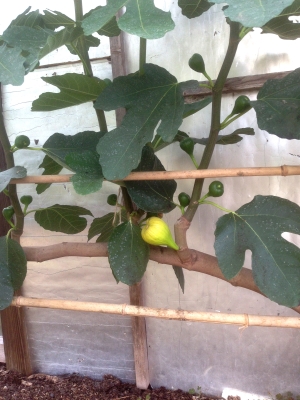
Early figs on old part of stem, later figs developing on new shoot
A nice offshoot (sic) of this bearing habit, for fig lovers/growers everywhere, is that fig plants are very quick to come into bearing. I’ve had plants bear the season after I rooted them from cuttings!
And many fig varieties potentially bear two crops each year. First to ripen is the crop borne on one-year-old stems. Later, the so-called main crop is born on new, growing shoots; this is the crop that continues ripening as the shoot grows, until stopped by cold weather and short days.
Why We Lust for Figs
I am among the many people, all over the world, who have wanted to grow figs. Fig was the first fruit I planted many years ago when I began gardening. I was living in Madison, Wisconsin where winter temperatures regularly plummeted to minus 25 degrees Fahrenheit!
Why the lust for figs? Perhaps because fig originated in one of the cradles of civilization, and is one of the oldest of cultivated fruits. It is the most mentioned fruit in the Bible (remember when Adam and Eve “knew that they were naked; and they sewed fig leaves together, and made themselves aprons.” It’s also one of the two sacred fruits of Islam, and figures prominently in Greek mythology.

Flavor has to figure in: A fully ripe fig is soft and juicy, with a honey sweet, rich flavor. If you already grow figs, I’m hoping my book will help you grow better or more figs, or be able to manage them more easily. If you haven’t yet experienced the rewards of growing figs, you have a treat in store for you.


